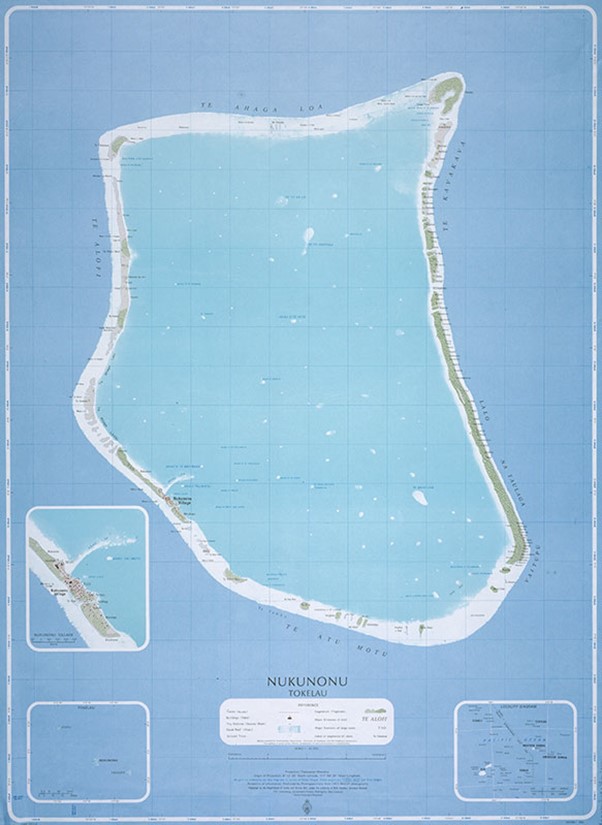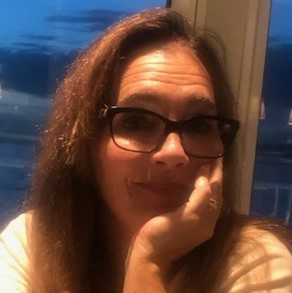A perspective from low laying atolls brings climate discourses and practical realities together. Tokelau experiences with political interventions employed by overseas agents range historically from instruments of demographic control to more recent measures related to transport and access to revenue from the EEZ. Tensions between different ways of being with the ocean are increasingly apparent.
Written by Ingjerd Hoëm

Fale, Fakaofo. Photo: Ingjerd Hoëm
Navigation: Spatial orientation on land and on the ocean
Many travelers in the Pacific have noted a tendency for island landscapes, languages, and forms of sociality to resemble one another, within but also across regional boundaries. The literature paints a picture of island cultures that almost seem like replicas of one another in spatial organisation and linguistically. This connection between place and language is especially noticeable in naming practices (Hoëm 1993). The practices associated with utilisation and occupation of space, local identity, and patterns of belonging, have been likened to maps charting social relationships locally and trans-locally. These maps or models serve as devices for navigation and speak of an orientation at once cosmological, social and geographical (Gell 1993, DeCoppet & Iteanu 1995). Thus Kirch writes of Lapita (early Austronesian) subsistence economy as “based on a strategy of transported landscapes” (Kirch 2000:111). In particular it is possible to trace parts of early migration patterns by following the transference of place-names from one island landscape to another, for example ’Uvea to Ouvea or Hawai’i to Savaii (see Kirch 2000:143).


Map of Nukunonu, Tokelau. Photographed copy provided by author.
This is important for the reading of local maps, what is “south” (tonga) as seen from one locality, may be north (tokelau) from the perspective of another (Senft et. al. 1997). Such directional pointers embedded in names serves purposes of spatial orientation for people who reside in a particular place. In ancient times, for people arriving in a new and unfamiliar place, to find a place to “land one’s waka” (canoe) was of utmost importance. To establish a “place to stand” (in Tokelauan tulaga; Maori turagawaewae), to claim a narrative of origin related to a particular place, was to create a foothold from which one could embark on the project of making a life in the new land.
Historically, we see a transformation from a pre-colonial situation where open ocean travel creates networks beyond the immediate atoll (Ono and Addison 2009; Huntsman 2013) to a century of debates over the provision of regular ocean transport and control over population movement with foreign owned large ocean-going vessels. In general, the picture is one where, as is the case in many other parts of the Pacific, freedom of movement beyond the atoll and its lagoon becomes increasingly restricted. From a ban on ocean travel between the atolls during the Second World War (see also Feinberg 1991), to decades of debates and promises by New Zealand to provide Tokelau with its own boat and means of transport to neighbouring Samoa, Tokelau runs its own motor vessel MV Mataliki built in 2015. The most recent controversy related to transport to and from Tokelau concerns the right by the Tokelau Public Service, or by its masters the General Fono to use revenues from Tokelau’s Exclusive Economic Zone to purchase a helicopter, potentially allowing more expedient health transport overseas. The purchase was deemed unlawful, and the helicopters were returned (Hoëm 2021).
 The ocean as a threat?
The ocean as a threat?
Until recently Tokelau had not been considered greatly endangered by the ocean, at least not in the sense of other Pacific Islands, as Tokelau used to be on the northern edge of the hurricane belt that runs across the Pacific with a main centre close to the Philippines. The atolls experienced high seas and strong winds with regularity during the wet season between November and March. The ongoing construction of seawalls by piling up coral stones and cement blocks and encaging them in chicken wire was initially considered a land-claim project. Until 1990, Tokelau had experienced only three recorded cyclones but the most recent one in 1987 (Tusi) was followed in 1990 by cyclone Ofa, which contaminated the freshwater lens and prevented plant growth for months.
The fact that the severe damage resulting from tropical cyclones may provide an occasion for political intervention and social engineering is clearly apparent in the aftermath of the January 1966 cyclone that struck Tokelau. The New Zealand government at the time had envisioned a plan for the resettlement of the Tokelau population to New Zealand, as villages on the atolls were considered too costly to maintain. The atolls, according to this plan, could then be used as coconut plantations. The resettlement scheme met with little success, however, as the atoll population were strongly opposed to abandoning their homeland. However, in the aftermath of the 1966 cyclone, with subsequent famine and hardship, three extended families (kaiga) agreed to resettle, and for the first time, migration outside of Samoa (and other local movements for shorter or longer periods) took place. The diagnosis was food shortage and overpopulation, and assisted migration was proposed as the solution.
In other words, the first outside notice of “overcrowding” in demographic terms, provided an opportunity for social engineering – one that led to what is today a diaspora of approximately 8,000 -10.000 Tokelauans living outside of Tokelau. As a consequence of this initial move population numbers in Tokelau fell from approximately 2000 to 1546 in the period between 1966 and 1982, and in New Zealand, the number of people from Tokelau increased to 2762 individuals (I. Prior in J. W. Smith et.al. 1997:54).
Because cyclone Ofa in 1990 was followed by a more rapid succession of cyclones – Val in 1992 and Percy in 2005 – villagers and scientists increasingly attribute the current weather pattern to climate change, that is, a result of global warming. In this perspective, the construction of seawalls takes on a new significance and a new sense of urgency. 2014 saw the first international climate demonstration ever conducted by Tokelauans, as a team joined the Pacific Warriors in peaceful protest, against the continuation of coal extraction in the Australian harbour of Newcastle. As the results of Tokelau’s last two referenda were to remain in their relationship of dependency with New Zealand, Tokelau no longer has its own voice in fora dedicated to climate issues, but in tandem with New Zealand representation.
In a Tokelau address to the international dialogue on climate, held in Kiribati in October 2015, Tokelau representative Paula Faiva, speaking on behalf of the Ulu o Tokelau explained:
While Tokelau appreciate that the issue of relocation has been dealt with favorably from New Zealand, allowing them access to their shores, the preference for Tokelauans is to also maintain a living community in the atolls for as long as it is at all possible.
This option, Faiva explained, provides Tokelauans with control over their own livelihoods; in short, it gives them a place to stand (tulaga). Trans-local and trans-national networks clearly represent a resource and alternative “places to stand,” ultimately providing other places to reside for the atoll population.
 Professor Ingjerd Hoëm is a social anthropologist working with Tokelau, including its diaspora. She works at the University of Oslo, and is affiliated with the OceanStates project. Her main interests are the articulation between Tokelau and overseas agencies modes of discourses, in particular ritualised forms of everyday- and political communication.
Professor Ingjerd Hoëm is a social anthropologist working with Tokelau, including its diaspora. She works at the University of Oslo, and is affiliated with the OceanStates project. Her main interests are the articulation between Tokelau and overseas agencies modes of discourses, in particular ritualised forms of everyday- and political communication.
References:
DeCoppet, D & A. Iteanu (eds) 1995 Cosmos and Society in Oceania. Oxford: Berg.
Feinberg, R. 1991 “A Longdistance Voyage in Contemporary Polynesia,” pp.25-44. In Journal of The Polynesian Society.
Gell, A. 1993 Wrapping in Images. Tattooing in Polynesia. Oxford: Clarendon Press.
Hoëm, I. 1993 “Space and Morality in Tokelau.” Pragmatics: Quarterly Publication of the International Pragmatics Association 3, no. 2: 137–153.
Hoëm, I. 2019 “Anthropos and Pragmata: On the Shape of Things to Come.” In Harvey, P; Krohn-Hansen, C & Nustad, K (eds.), Anthropos and the Material. Duke University Press. pp. 81–100.
Hoëm, I. 2021 “ ‘Cutting the Colonial Cord’? Tensions of Value and the Relationship between Tokelau and New Zealand.” In Oceania No 91(2), pp. 165–180.
Huntsman 2013 in Hooper A. & J.Huntsman (eds) Tokelau: An Historical Ethnography. Auckland: Auckland University Press.
Kirsch. P. 2000 On The Road of the Winds: An Archaeological History of the Pacific Islands Before European Contact. Berkeley: University of California Press.
Ono, R and D.J. Adisson 2009. “Historical Ecology and 600 Years of Fish Use on Atafu Atoll, Tokelau.” In Prehistoric Marine resource Use in the Indo-Pacific Regions. R. Ono, A. Morrison & D. Addison (eds.). Canberra: ANU Press.
Prior, Ian 1986, in Smith J.W et. al. 1997. Healing a Wounded World: Economics, Ecology and Health for a Sustainable Life. Westport: Praeger Publishers.
Sahlins, M. 1958. Social Stratification in Polynesia. Seattle: University of Washington Press.
Senft et. al. 1997. Referring to Space. Oxford: Clarendon Press.